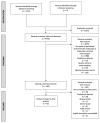Specialised Surgical Instruments for Endoscopic and Endoscope-Assisted Neurosurgery: A Systematic Review of Safety, Efficacy and Usability
- PMID: 35740595
- PMCID: PMC9221041
- DOI: 10.3390/cancers14122931
Specialised Surgical Instruments for Endoscopic and Endoscope-Assisted Neurosurgery: A Systematic Review of Safety, Efficacy and Usability
Abstract
While there have been great strides in endoscopic and endoscope-assisted neurosurgical approaches, particularly in the treatment of deep-sited brain and skull base tumours, the greatest technical barrier to their adoption has been the availability of suitable surgical instruments. This systematic review seeks to identify specialised instruments for these approaches and evaluate their safety, efficacy and usability. Conducted in accordance with the PRISMA guidelines, Medline, Embase, CENTRAL, SCOPUS and Web of Science were searched. Original research studies that reported the use of specialised mechanical instruments that manipulate tissue in human patients, cadavers or surgical models were included. The results identified 50 specialised instruments over 62 studies. Objective measures of safety were reported in 32 out of 62 studies, and 20 reported objective measures of efficacy. Instruments were broadly safe and effective with one instrument malfunction noted. Measures of usability were reported in 15 studies, with seven reporting on ergonomics and eight on the instruments learning curve. Instruments with reports on usability were generally considered to be ergonomic, though learning curve was often considered a disadvantage. Comparisons to standard instruments were made in eight studies and were generally favourable. While there are many specialised instruments for endoscopic and endoscope-assisted neurosurgery available, the evidence for their safety, efficacy and usability is limited with non-standardised reporting and few comparative studies to standard instruments. Future innovation should be tailored to unmet clinical needs, and evaluation guided by structured development processes.
Keywords: cancer; endoscopy; keyhole surgery; surgical instruments.
Conflict of interest statement
The authors declare that the research was conducted in the absence of any commercial or financial relationships that could be construed as a potential conflict of interest. The funders had no role in the design of the study; in the collection, analyses, or interpretation of data; in the writing of the manuscript, or in the decision to publish the results.
Figures
Similar articles
-
The effectiveness of internet-based e-learning on clinician behavior and patient outcomes: a systematic review protocol.JBI Database System Rev Implement Rep. 2015 Jan;13(1):52-64. doi: 10.11124/jbisrir-2015-1919. JBI Database System Rev Implement Rep. 2015. PMID: 26447007
-
Robotic and robot-assisted skull base neurosurgery: systematic review of current applications and future directions.Neurosurg Focus. 2022 Jan;52(1):E15. doi: 10.3171/2021.10.FOCUS21505. Neurosurg Focus. 2022. PMID: 34973668
-
Beyond the black stump: rapid reviews of health research issues affecting regional, rural and remote Australia.Med J Aust. 2020 Dec;213 Suppl 11:S3-S32.e1. doi: 10.5694/mja2.50881. Med J Aust. 2020. PMID: 33314144
-
Robotics in keyhole transcranial endoscope-assisted microsurgery: a critical review of existing systems and proposed specifications for new robotic platforms.Neurosurgery. 2014 Mar;10 Suppl 1:84-95; discussion 95-6. doi: 10.1227/NEU.0000000000000123. Neurosurgery. 2014. PMID: 23921708 Review.
-
Robotic Handle Prototypes for Endoscopic Endonasal Skull Base Surgery: Pre-clinical Randomised Controlled Trial of Performance and Ergonomics.Ann Biomed Eng. 2022 May;50(5):549-563. doi: 10.1007/s10439-022-02942-z. Epub 2022 Mar 8. Ann Biomed Eng. 2022. PMID: 35258744 Free PMC article. Clinical Trial.
Cited by
-
Harmonized technical standard test methods for quality evaluation of medical fluorescence endoscopic imaging systems.Vis Comput Ind Biomed Art. 2025 Jan 10;8(1):2. doi: 10.1186/s42492-024-00184-5. Vis Comput Ind Biomed Art. 2025. PMID: 39792300 Free PMC article.
-
Non-Metallic MR-Guided Concentric Tube Robot for Intracerebral Hemorrhage Evacuation.IEEE Trans Biomed Eng. 2023 Oct;70(10):2895-2904. doi: 10.1109/TBME.2023.3268279. Epub 2023 Sep 27. IEEE Trans Biomed Eng. 2023. PMID: 37074885 Free PMC article.
-
A Handheld Robot for Endoscopic Endonasal Skull Base Surgery: Updated Preclinical Validation Study (IDEAL Stage 0).J Neurol Surg B Skull Base. 2024 Apr 15;86(2):191-198. doi: 10.1055/a-2297-3647. eCollection 2025 Apr. J Neurol Surg B Skull Base. 2024. PMID: 40104539 Free PMC article.
-
Current and Future Advances in Surgical Therapy for Pituitary Adenoma.Endocr Rev. 2023 Sep 15;44(5):947-959. doi: 10.1210/endrev/bnad014. Endocr Rev. 2023. PMID: 37207359 Free PMC article.
-
Identifying research priorities for pituitary adenoma surgery: an international Delphi consensus statement.Pituitary. 2025 Mar 5;28(2):36. doi: 10.1007/s11102-025-01502-7. Pituitary. 2025. PMID: 40042764 Free PMC article.
References
-
- Carroll L. Through the Looking-Glass and What Alice Found There. Macmillan; London, UK: 1871.
-
- Marcus H.J., Cundy T.P., Hughes-Hallett A., Yang G.Z., Darzi A., Nandi D. Endoscopic and keyhole endoscope-assisted neurosurgical approaches: A qualitative survey on technical challenges and technological solutions. Br. J. Neurosurg. 2014;28:606–610. doi: 10.3109/02688697.2014.887654. - DOI - PMC - PubMed
Publication types
LinkOut - more resources
Full Text Sources





